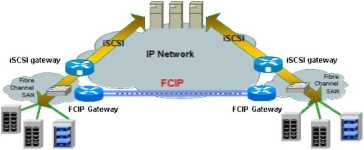9818247291
SAN Security Protocols and Mechanisms
FCIP transports Fibrę Channel data by creating a tunnel between two endpoints in an IP network. Frames are encapsulated into TCP/IP at the sending end. At the receiving end, the IP wrapper is removed and native Fibrę Channel frames are delivered to the destination fabric. This technique is commonly referred to as tunneling, and has historically been used with non-IP protocols such as AppleTalk and SNA. Usage of the FCIP as well as iSCSI protocols is illustrated in Exhibit 8.

Exhibit 8: FCIP and iSCSI Solution Architecture
The technology is implemented using FCIP gateways, which typically attach to each local SAN through an expansion-port connection to a Fibrę Channel switch. Ali storage traffic destined for the remote site goes through the common tunnel. The Fibrę Channel switch at the receiving end is responsible for directing each frame to its appropriate Fibrę Channel end device.
Multiple storage conversations can concurrently travel through the FCIP tunnel, although there is no differentiation between conversations in the tunnel. An IP network management tool could view the gateways on either side of the tunnel, but cannot view in on the individual Fibrę Channel transactions moving within the tunnel. The tools would thus view two FCIP gateways on either side of the tunnel, but the traffic between them would appear to be between a single source and destination, not between multiple storage hosts and targets.
Connecting Fibrę Channel switches creates a single Fibrę Channel fabric analogous to bridged LANs or other Layer 2 networks. This means that connecting two remote sites with FCIP gateways creates one Fibrę Channel fabric that can extend over miles. This preserves Fibrę Channel fabric behavior between remote locations but could leave the bridged fabric vulnerable to fabric reconfigurations or excessive fabric-based broadcasts.
2.6 Other SAN Protocols
There are several other SAN protocols which are in IETF draft proposal or development like Internet Fibrę Channel Protocol (iFCP) or Internet Storage Name Services (iSNS). iFCP is also a gateway-to-gateway approach in which FC frames are encapsulated directly into IP packets and IP addresses are mapped to a FC devices. This is morę iP-oriented scheme than the IP tunneled SCSI frames FCIP, but is a morę complex protocol that was designed to overcome the potential vulnerabilities of stretched fabrics, enable multi-point deployments and provide native IP addressing to individual Fibrę Channel transactions.
iSNS protocol is used for interaction between iSNS servers and iSNS clients in order to facilitate automated discovery, management, and configuration of iSCSI and FC devices on a TCP/IP network. iSNS provides intelligent storage discovery and management services comparable to those found in FC
Wyszukiwarka
Podobne podstrony:
SAN Security Protocols and Mechanisms 13 4.1.3 Fibrę Channel Security Protocols To address additiona
SAN Security Protocols and Mechanisms 14 4.1.3.1.2 Fibrę Channel Authentication Protocol Fibrę Chann
SAN Security Protocols and Mechanisms The invention of a Fibrę Channel (FC) has opened a complete ne
SAN Security Protocols and Mechanisms Exhibit 6: Fibrę Channel Protocol Stack The lowest level (FC-0
SAN Security Protocols and Mechanisms 10 networks, allowing a commodity IP network to function in a
SAN Security Protocols and Mechanisms 3.3 Access Control and Authentication Another critical aspect
SAN Security Protocols and Mechanisms 12 One host or storage device could also belong to a multiple
SAN Security Protocols and Mechanisms 15 4.1.3.2FC-SP per frame confidentiality and integrity Recogn
SAN Security Protocols and Mechanisms 16 FC-2 Payload: 0-528 Transmission
SAN Security Protocols and Mechanisms 17 • Data Origin Authentication The IPsec re
SAN Security Protocols and Mechanisms endpoints can be determined, the true source and destination e
SAN Security Protocols and Mechanisms 19 An iSCSI node must also support Internet Key Exchange (IKE)
SAN Security Protocols and Mechanisms_2_ Storage Area Networks Security Protocols and Mechanisms Ind
SAN Security Protocols and Mechanisms 20 6 Futurę directions Storage security is still evolving topi
SAN Security Protocols and Mechanisms Index of Exhibits Exhibit 2: NAS
SAN Security Protocols and Mechanisms Storage Area Networks Security Protocols and Mechanisms 1 Intr
SAN Security Protocols and Mechanisms Storage or shortly NAS. NAS architecture consist of a dedicate
SAN Security Protocols and Mechanisms iSCSI enables SCSI-3 commands to be encapsulated in TCP/IP pac
więcej podobnych podstron